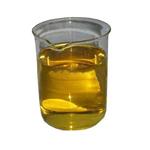Naphthas derived from both petroleum and
coal tar are included in this group. Petroleum naphthas are
colorless liquids. Gasoline or kerosene-like odor. A mixture
of paraffins (C5-C13) that may contain a small amount of
aromatic hydrocarbons, and are termed “close-cut” fractions.
“Medium-range” and “wide-range” fractions are
made up of 40-80% aliphatic hydrocarbons; 25-50%
naphthenic hydrocarbons; 0-10% benzene, and 0-20%
other aromatic hydrocarbons.
reddish-brown mobile liquid with aromatic odour
Pharmaceutic aid (solvent).
Diluent for paints, coatings, resins,
printing inks, rubbers, and cements; solvent.
High flash naphtha C19 aromatic hydrocarbon components
are obtained by dehydrogenating naphthenes and are primarily
ethyltoluene and trimethylbenzene.
A general term applied to refined, partly refined, or
unrefined petroleum products and liquid products of
natural gas, not less than 10% of which distill below
347F (175C) and not less than 95% of which distill
below 464F (240C) when subjected to distillation
in accordance with the Standard Method of Test
for Distillation of Gasoline, Naphtha, Kerosene,
and Similar Petroleum Products
A clear colorless to dark brownish colored liquid with an aromatic odor. Less volatile fraction separated from coal tar by distillation. Contains naphthalene, acenaphthene, methylnaphthalenes, fluorene, phenol, cresols, pyridine, picolines, among other substances. Flash point greater than 100 °F. Toxic by inhalation and skin absorption. Less dense than water and insoluble in water. Vapors heavier than air.
Highly flammable. Insoluble in water.
Saturated aliphatic hydrocarbons, which are contained in NAPHTHA, may be incompatible with strong oxidizing agents like nitric acid. Charring of the hydrocarbon may occur followed by ignition of unreacted hydrocarbon and other nearby combustibles. In other settings, aliphatic saturated hydrocarbons are mostly unreactive. They are not affected by aqueous solutions of acids, alkalis, most oxidizing agents, and most reducing agents. When heated sufficiently or when ignited in the presence of air, oxygen or strong oxidizing agents, they burn exothermically to produce carbon dioxide and water. May be ignited by strong oxidizers. Incompatible with strong oxidizers .
Flammable, dangerous fire risk, explosive
limits in air 1–6%.
Primarily a narcotic, causing unconsciousness in high concentrations. The symptoms of acute benzene poisoning are not likely, since the compound has components other than benzene.
Flammability and Explosibility
Extremely flammable
A human poison via
intravenous route. Experimental
carcinogenic effects reported by skin
contact. Human systemic effects by
intravenous route: dyspnea, respiratory
stimulation, and other unspecified
respiratory effects. Mildly toxic by
inhalation. Can cause unconsciousness,
which may be followed by coma, stentorious
breathing, and bluish tint to the skin.
Recovery follows removal from exposure. In
mild form, intoxication resembles
drunkenness. On a chronic basis, no true poisoning; sometimes headache, lack of
appetite, dizziness, sleeplessness,
indigestion, and nausea. A common air
contaminant. Flammable liquid when
exposed to heat or flame; can react with
oxidzing materials. Keep containers tightly
closed. Slight explosion hazard. To fight fire,
use foam, CO2, dry chemical.
Naphthas are used as organic solvents
for dissolving or softening rubber, oils, greases, bituminous
paints, varnishes, and plastics. The less flammable fractions
are used in dry cleaning. The heavy naphthas are used as a
vehicle for various pesticides. Coal tar naphthas are used as quick-drying paint solvent; in the manufacture of floor coverings;
resin solution; varnish; VM&P naphtha is used as a
solvent for lacquers and varnishes and as a rapid-dry paint
thinner.
UN1136 Coal tar distillates, flammable, Hazard
Class: 3; Labels: 3-Flammable liquid.
Incompatible with oxidizers (chlorates,
nitrates, peroxides, permanganates, perchlorates, chlorine,
bromine, fluorine, etc.); contact may cause fires or explosions.
Keep away from alkaline materials, strong bases,
strong acids, oxoacids, epoxides.
The initial threshold screening level (ITSL) for naphtha has been changed from 3,500 μg/m3 (8-hour averaging time) to 4,000 μg/m3 (8-hour averaging time).
Dissolve or mix the material
with a combustible solvent and burn in a chemical
incinerator equipped with an afterburner and scrubber.
All federal, state, and local environmental regulations must
be observed.

